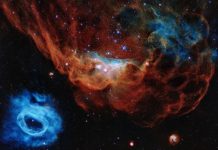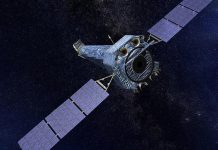Feb. 1 (UPI) — The Hubble constant, the universe’s rate of expansion, is greater than many scientists thought.
The new findings, detailed in the Monthly Notices of the Royal Astronomical Society, confirm the conclusions of another similar survey — that the cosmos is expanding at an accelerated clip.
Previous attempts to measure the Hubble constant have focused on variable stars and supernovae. The latest efforts, led by astronomer Sherry Suyu, used the Hubble Space Telescope to image the light of distant quasars, extra bright galaxy cores, as it bends around galaxies on its way to Earth.
Researchers focused Hubble on the gravitational lensing of six galaxies. As the light from the distant quasars is warped by the gravity of the intermediate galaxy, it becomes both magnified and fractured. The lensing events allowed Hubble to receive multiple images of each quasar.
Because the galaxies aren’t perfectly round, the quasar light is bent at a variety of odd angles, creating delays. Some light waves takes a shorter path, while other light waves travel a longer path. These anomalies are compounded by the quasar’s own variability, causing the quasar images to flicker.
These flickers can be used to calculate the Hubble constant.
“Our method is the most simple and direct way to measure the Hubble constant as it only uses geometry and General Relativity, no other assumptions,” Frederic Courbin, an astronomer at the Swiss Federal Institute of Technology in Lausanne, said in a news release.
Measuring the Hubble constant and understanding the expansion of the universe is essential to modeling the birth and evolution of the cosmos.
“The Hubble constant is crucial for modern astronomy as it can help to confirm or refute whether our picture of the universe — composed of dark energy, dark matter and normal matter — is actually correct, or if we are missing something fundamental,” said Suyu.
Suyu is a researcher at the Institute of Astronomy and Astrophysics in Taiwan, and visiting fellow at the Max Planck Institute for Astrophysics.
Though the latest findings support the conclusions of the Hubble constant survey conducted using the ESA Planck satellite — which calculated a faster-than-expected expansion of the distant universe — the numbers remain at odds with rates of expansion measured in the local universe.
The discrepancies may force scientists to develop new models.
“The expansion rate of the universe is now starting to be measured in different ways with such high precision that actual discrepancies may possibly point towards new physics beyond our current knowledge of the universe,” concluded Suyu.






